Can I use gluten free flour in place of regular flour in a recipe? That is one of the questions I get asked the most about gluten free baking. After testing quite a few different blends over the last eleven years, I am sharing my thoughts.
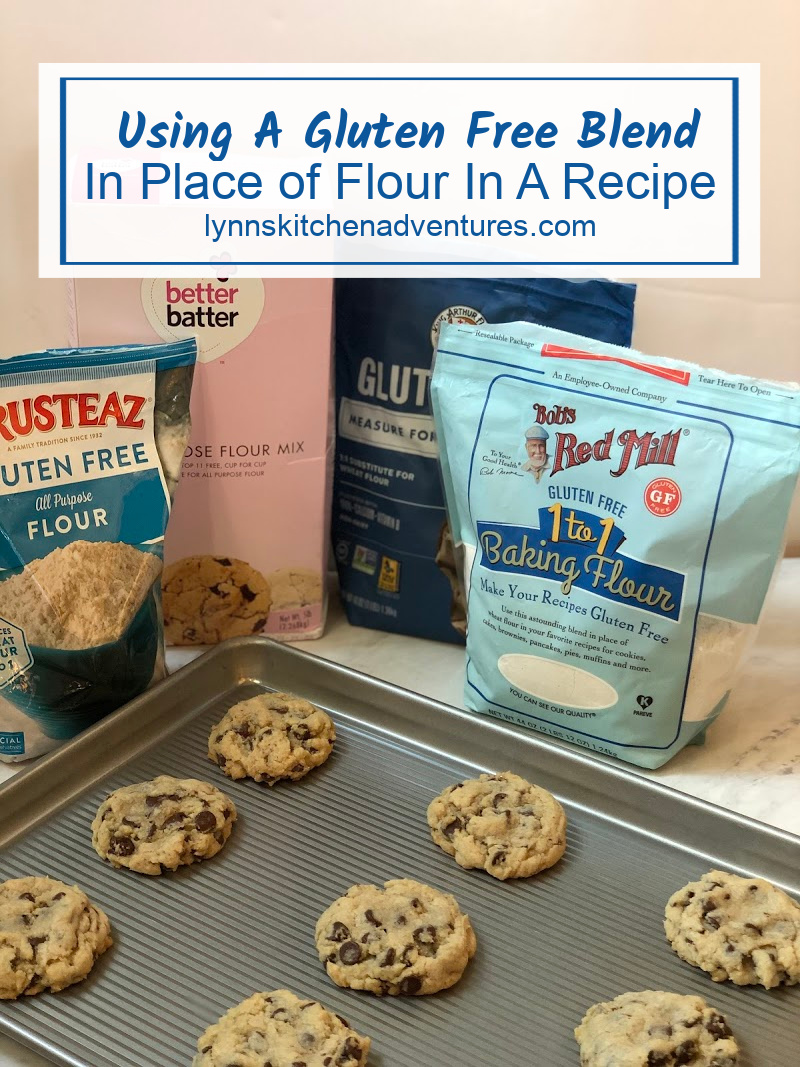
Have you ever wondered what gluten free blend to use when a recipe just says, “Use a gluten free blend in place of flour”? Or even when it just says, “Use 2 cups of a gluten free flour blend”?
One of my biggest complaints about online gluten free recipes is that they often don’t specify which gluten free blend they used to make the recipe.
It Matters What Gluten Free Blend You Use
I am going against popular opinion by saying that it does matter what blend that you use. Can you use any blend? Technically, yes, you can. Will you get the same results? Probably not.
When I make a gluten free cookie or a gluten free cake or any other gluten free dessert, I want it to be so good that you can’t tell that it is gluten free.
I want my husband and son, who do not have to eat gluten free, to enjoy it too. I want to be able to serve my gluten free food to family and friends. I want people to be shocked when they find out something I made is gluten free because it is so good that they could not tell a difference from a gluten-filled version.
I put a lot of thought and time into using the right gluten free products for the recipe in order to get the best result.
Sometimes that is using individual gluten free flours, but sometimes that is using a specific gluten free flour blend.
See those two batters? The bottom one is much thicker than the top one. The only difference between those two batters was the flour blend.
They were the exact same gluten free banana bread recipe made with the same ingredients at the same time. The only difference was the brand of gluten free flour blend I used.
I tested the best flour for gluten free banana bread and the brand of the blend made a huge difference in both the batter and the final loaf.
These cookies are another example. These gluten cookies were made on the exact same day using the exact same recipe and ingredients. The only difference was the brand of gluten free flour blend.
The top cookies spread out more and were much thinner. The bottom ones were thicker and did not spread out the same. The top ones had a great texture. The bottom ones were fine, but not nearly as good.
The brand of blend made a big difference in the final results. All the cookies got eaten, but the top ones got eaten much faster because those who ate them enjoyed them much more.
Why Does It Matter Which Gluten Free Flour Blend I Use?
Gluten free flour blends vary a lot. The ingredients and ratios can be totally different in two different gluten free flour blends. Those differences can change both the taste and the texture of a recipe’s final results.
Have you ever tasted a gluten free cookie that tastes like a gluten free cookie? Or have you ever taken a bite of a gluten free cake and realized that it had an odd texture? Those things are often caused by the brand of gluten free flours used in the recipe.
What Is the Difference in Gluten Free Flour Blends?
The difference is the ingredients. The ratio of flours to starches varies. The amount of gums also varies by brand. The texture of the grains can vary. Some brands of gluten free blends are ground much finer than others.
Here are a few examples of the different ingredients in gluten free flour blends:
- The main ingredients in the King Arthur blend are rice flours, sorghum flour, tapioca starch, and potato starch. The first ingredients in this blend are white and brown rice flours.
- The main ingredients in the Krusteaz gluten free blend are sorghum flour, brown rice flour, millet flour, and rice flour. The first ingredient in this blend is sorghum flour.
- The Better Batter blend contains pectin. It is the only blend that I have seen with pectin.
- The main ingredients in Bob’s Red Mill 1-to-1 blend are sweet rice flour, brown rice flour, potato starch, and sorghum.
- The Cup 4 Cup gluten free flour blend contains milk.
- The main ingredient in the Wal-Mart Great Value brand is rice flour, including sweet rice flour.
Do you see what I mean? There is a big difference between the different blends.
When you use a “regular” all purpose flour in a recipe, you pretty much know what you get. It can vary some in quality, but it is still regular all purpose flour. That is not the case with gluten free flour blends. Each blend is different.
What Happens if I Use a Different Gluten Free Blend in a Recipe?
If you use a gluten free blend that is different than the one specified in a recipe, the final result will probably vary from the original recipe.
Will it still be good? That answer varies. Most of the time the recipe turns out fine, but that is not always the case. Many times I find that the recipe is something we can eat, but it is not as good as it was with the original recipe and blend.
An example of this is in the brownies I tested. I used different blends in the same brownie recipe to see what the best flour for gluten free brownies is. Each blend gave me different results. One blend was so bad we threw some of the brownies out because no one would eat them.
The same thing happened when I tested flour blends to see what the best flour for gluten free banana bread is. There was a difference in both taste and texture with each blend. Part of one loaf of bread ended up in the trash because it was so bad.
I am working on testing the best flour for gluten free cookies and will share the results soon. But for now, I will say that the blend made a difference.
When I make a gluten free recipe, I want the best results possible. I want the final product to be so good that you cannot tell that it is gluten free.
Throwing out food is expensive and a waste of time. I don’t want to use a gluten free flour blend in a recipe that doesn’t work well for that recipe.
Always Specify What Blend You Use When Sharing Recipes
I always try to specify what blend I use when I share gluten free recipes here on my site as well as with family and friends. I do not want you to waste time or money when it comes to gluten free baking.
Can I use a gluten free blend in place of regular flour in a recipe? Yes, but since gluten blends vary, it is important to know what blend I use for the recipe.
I want you to have an end result that is not just good. I want the end result to be great. I want you to enjoy a final product, which should be so good that you can’t tell that it is gluten free.
That is why I test my gluten free recipes over and over again. That is why I will continue to test different blends in different recipes to figure out which blend gives you the best results.
What Is My Favorite Blend
For years, my favorite blend has been Bob’s Red Mill 1-to-1 gluten free blend. I have tried quite a few blends over the last eleven years of eating gluten free, but Bob’s Red Mill 1-to-1 Blend usually works well in recipes. It is also usually fairly easy to find.
However, ingredients and blends have been harder to find in 2020, so I am finding myself trying whatever brand I can find in stores or in stock online. As I have tried more blends, I have confirmed what I have always thought: there really is a huge difference in brands.
After taste testing different blends in the same exact recipe with the same exact ingredients and only varying the brand, my family has two clear favorites.
For the overall best taste and texture in the majority of recipes, we like Bob’s Red Mill 1-to-1 gluten free flour blend or King Arthur Measure for Measure gluten free flour blend. We have tried them both in cookies, banana bread, brownies, and more. They both worked every time.
We have also been impressed with the Krusteaz gluten free flour. It was the top choice for several in my family for banana bread. The cookies we made with it had a great texture, although they did have a slight gluten free taste. The Krusteaz gluten free flour has more whole grains than Bob’s Red Mill or King Arthur, so it does tend to give recipes a healthier taste. I don’t think we would like it for everything, but we have been impressed with it so far. I will keep you updated as I use it more.
I have not been impressed with the Better Batter gluten free flour. Multiple recipes that I have used this blend in have ended up in the trash. We did not like the taste or texture. This blend has pectin in it, and I think that just changes the recipes too much. I doubt I will try this blend again because I am tired of throwing out the baked goods I used it in.
I am often asked why I don’t use Cup 4 Cup gluten free blend because it is a popular blend. Cup 4 Cup contains milk. My daughter eats mainly dairy free. The only dairy she really eats is butter in desserts. Besides that, she avoids dairy because of health issues. I haven’t wanted to try a blend that she couldn’t have.
I have heard great things about the Wal-Mart gluten free flour blend. I bought some recently, and I will share my thoughts on that blend soon.
I have had readers ask me about Pamela’s gluten free flours. Some of Pamela’s products have nut flours in them. My daughter has a tree nut and peanut allergy, so I avoid most of Pamela’s products.
Some gluten free blends contain bean flours. I avoid those blends because my family doesn’t like the taste of bean flours. I also think bean flours tend to make the final results heavier or denser than other blends.
A Few More Thoughts
Can I use gluten free flour in place of regular flour? The answer is yes, you can use gluten free flour in place of regular flour. However, not all blends are equal.
If you are new to gluten free, pick a blend like Bob’s Red Mill 1-to-1 gluten free blend or King Arthur Measure for Measure gluten free blend. When you get used to gluten free baking, experiment more with different blends.
If you have a blend that you use and love, use it. What my family likes about a recipe you might not like. We all have different tastes and preferences.
However, just know that the final results may vary. If you use a different gluten free flour blend than the recipes states, you have changed the recipe. The results may not be the same.
In some recipes, like my gluten free cinnamon rolls, homemade gluten free rolls, gluten free chocolate cake, and others, I still prefer to use the individual flours. In some recipes, you get much better results using specific individual flours for each recipe.
Gluten free products are constantly coming and going. New ones are being produced and other ones are discontinued. As I find new blends to try, I will continue to test blends and share the results with you.

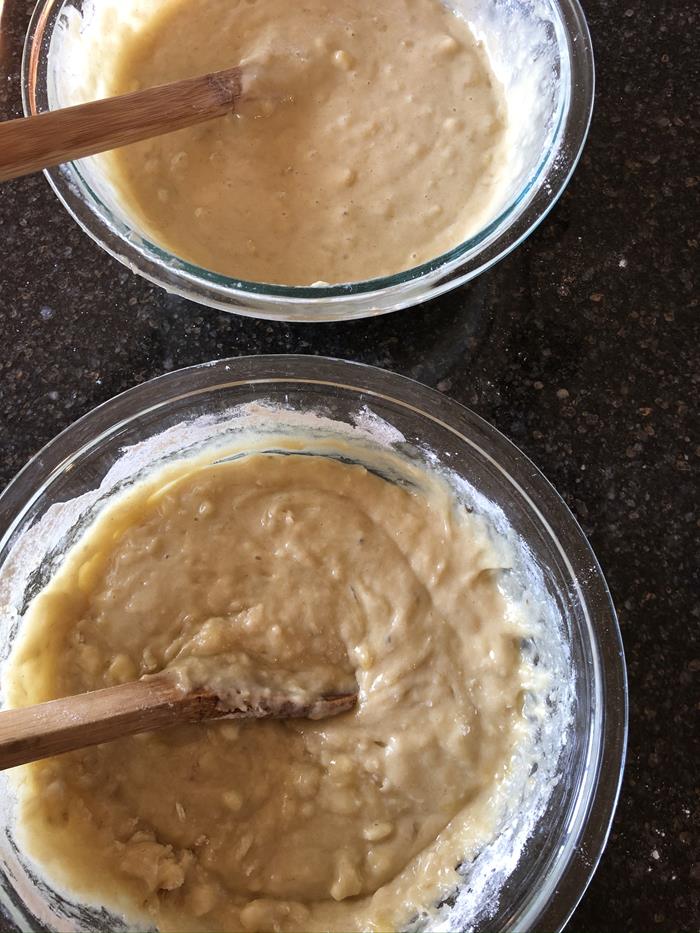
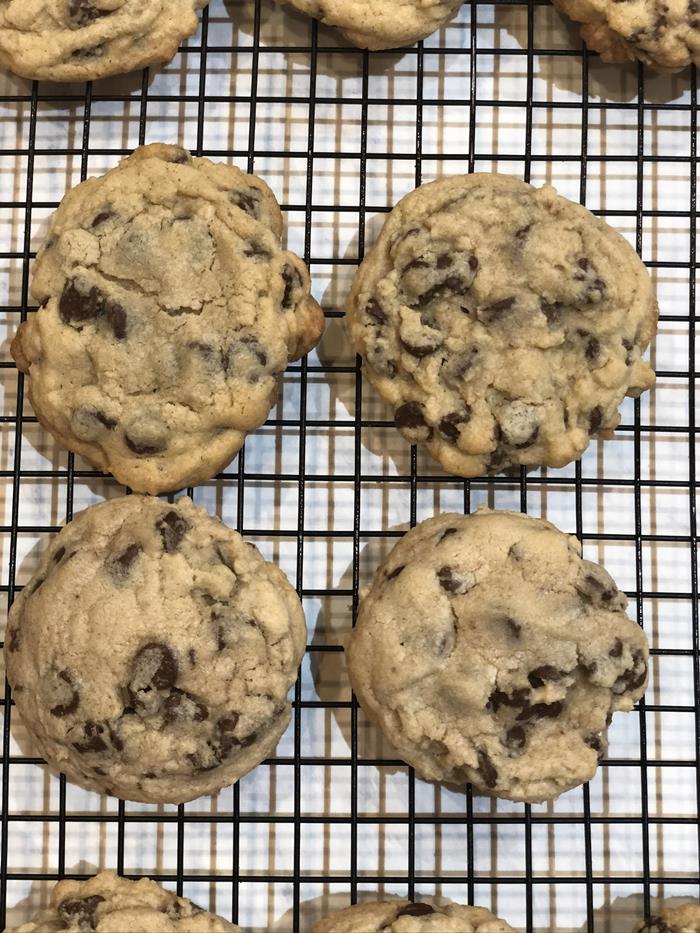
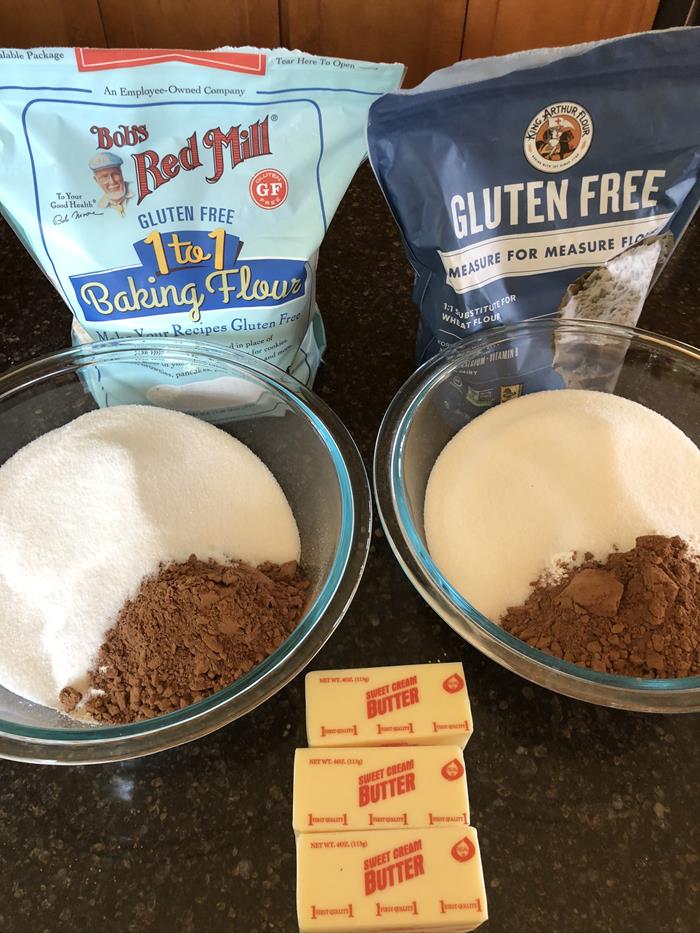
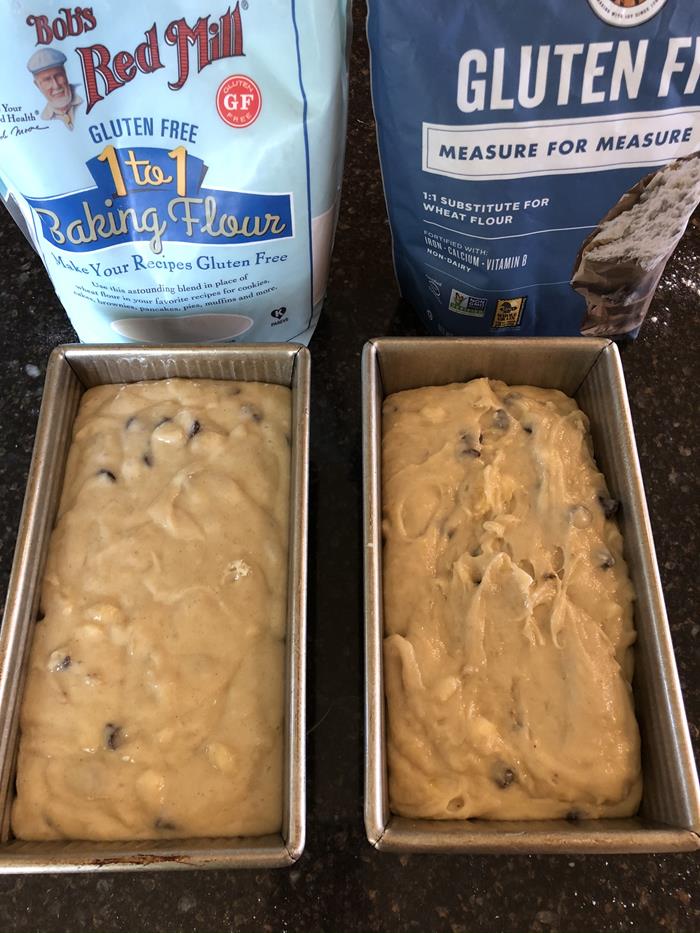
Would Bob’s red Mill bread flour – gluten-free – be a good substitute for regular bread flour in making artisan bread?
I have not had a lot of success with gluten-free blends in yeast bread. Sometimes it works, but I prefer the individual flours. That being said I am always willing to experiment, so I would say try it and see. I might just try a small loaf or a recipe that uses just a couple of cups of flour. That way if it doesn’t work well you are not out a lot of expense. I hope that helps.
I have tried gluten free flour in apple crisp. The top does not get crumbling, it is soft and kind of mushy. Any suggestions?
I would try a blend with sorgum in it. It might brown better. However, the apple crisp in this picture is gluten free made with a gf blend and it browns up fairly well. https://www.lynnskitchenadventures.com/martha-stewarts-apple-crisp/ I hope that helps.
Hi Lynn,
I used Bob’s GF 1-1 flour for choc chip cookies and they came out horrible! They were flat and not tasty at all! Would you recommend a different flour such as King Arthur’s? I’m struggling with baking recipes/ingredients that contain low Fodmaps and are gluten friendly. I appreciate your advice!
Thank you,
Jennifer
Every recipe is a little different. Bob’s 1 to 1 GF bleand and King Arthur’s GF blend are my favorite gluten free blends. If one doesn’t work in a recipe I usually try the other one. Sometimes I also find that individual flours work better than a blend. Changing multiple things in a recipe can really alter the results, so that might be part of the issue too. I hope that helps.
I want to make apple dumplings to surprise my niece so I can I use gluten free flour for my pie crust? I bought arrow head gluten free flour. Thanks
That depends. I have not used the Arrow Head blend. I do like the Bob’s Red Mill Gluten Free Pie Crust mix and it might work well for dumplings. Gluten free pie crust is harder to work with because the texture is different. I haven’t tried it in dumplings, but I think it is worth trying.
Hi Lynn
I have been trying to make a gluten free artisan style bread with added ingredients like cheese I have used many recipes with different flour blends like the ones you mentioned
Nothing is working they all come out totally wrong dense gross tasting and flat I really like jeff hertzberg artisan bread can I use 1 to 1 gf flour instead of ap flour thanks for all help and suggestions
Blends work differently in recipes, especially yeast bread so I am not sure the 1 to 1 gf blend will work in the normal artisan bread recipe. I used to make that all the time too and loved it before going gluten free. Gluten free yeast breads are a little challenging to make because it doesn’t have the gluten. I think Jeff Hertzberg has a gluten free cookbook have you tried any of the recipes in it?
What about using gluten free in sausage balls?
I have not tried it, but I know people that have. Gluten Free Bisquick should also work well.
I have a recipe for peach cobbler with canned peaches which call for 2 cups all purpose flour for the topping. Can I use gluten free flour in its place and if so what do I alter or add to this recipe? Thank you
I have had good success with using a gluten free blend in fruit cobblers and crisps, so I think it is worth trying in your recipe. I would use Bob’s Red Mill 1 to 1 Gluten Free Blend or King Arthur’s Gluten Free Blend. Those are my two favorite gluten free blends to use. I hope that helps. And I am sorry that it took me so long to reply. I took yesterday off from online work.
topping for peach cobbler calls for 2 cups all purpose flour. Can I use gluten free flour instead and if so do I add/alter to make it work.
This article is SO helpful! My daughter was diagnosed with Celiac about a year ago, and I have been overwhelmed with all the different flours and which ones are best for particular recipes. Some we have liked and some we have not been so happy with. And with the price of gf flours, it’s been a pretty painful experiment to figure out which flours we like.
Do you have a flour suggestion for making sausage, or “country”, gravy or a roux? And should I reduce the amount of gf flour when making it? In the past I have always done a simple ratio of like 4tbsp butter/grease, 4tbsps flour, and 2 cups milk. I’ve substituted gf flour equally but it seems to thicken it way too much. I also do similar when making a roux for homemade mac and cheese sauce. It just thickens too much and then we end up not enjoying it too much.